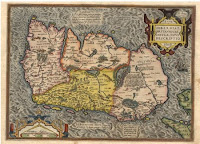It is not unusual for Christian symbols of the cross to have variation. We all recognize the two straight lines perpendicular to each other, with a horizontal one shorter than the vertical one, and spaced about one-quarter to one-third from the top of the vertical.
There is, however, an upside-down or inverted cross in Christian tradition, the Cross of St. Peter. In Catholic tradition, when Peter was to be crucified he requested that the cross be upside-down. This comes from the "Acts of Peter," a 2nd-century Greek apocryphal work. The author says that Peter's request was to make a point that the beliefs of his persecutors were opposite of what they should be.
But there is also St. Andrew's Cross, the shape called saltire. It most resembles the letter "X"; it is named for St. Andrew because of the tradition that he was martyred by being bound to an X-shaped crucifix.
With those examples in mind, let's look at St. Brigid's Cross, associated with Brigid of Kildare. (The image above is from a site that will show you how to make it.) traditionally, Brigid's Cross is made from freshly cut reeds on 1 or 2 February, the cross-quarter festival of Candlemas. The rushes or reeds were pulled on the eve of her day, then crosses were made the next day to protect the home during the coming year.
I think this cross is just one more piece of evidence that Brigid was a legend, not a living person. Despite the stories—and even physical relics that exist but only appeared centuries after she supposedly lived—it seems more likely, as some historians believe, that the stories of St. Brigid are a Christianization of the Celtic goddess Brigid, a member of the Tuatha Dé Danann.
There is no real evidence for her existence. The miracles attributed to her parallel some stories out of folklore. Kildare, where she established a monastery, comes from Gaelic Cill Dara, "Church of the Oak," an oddly pagan-sounding name for a Christian church. Her feast day is Imbolc, the pre-Christian calendar's start of spring. She was raised in the house of a druid (!), and a white cow magically appeared to provide milk for her—not a unique animal to show up in times of need in Celtic folklore. St. Brigid and the goddess Brigid have some of the same associations: healing, metalwork, dairy workers, farming.
Her cross is different from other Christian cross variations, not just by its shape, but because the shape seems secondary to its construction from natural materials, still green, and re-created annually to ensure protection. Certainly, crosses and crucifixes are worn for protection, as are other amulets and talismans, but the Brigid Cross is so connected to Nature that it allies more closely to the pre-Christian traditions in Ireland than the later introduction of Christianity.
There are historical figures tied to her legend though, like the King of Leinster and St. Patrick. That king and Brigid's mother Broicsech were both baptized by Patrick. The Book of Armagh, relied on for its early texts about Patrick, clearly states the important friendship between Patrick and Brigid. Patrick died c.461, however, and the best sources for St. Brigid claim she was born c.451.
Speaking of the two, however: the Brigid story also states that her mentor was Mél of Ardagh, who was Patrick's nephew. I have to confess that in none of the reading I have done about St. Patrick have I seen references to his extended family—and it turns out it was pretty extensive! Tomorrow we'll look at the relatives of St. Patrick.












